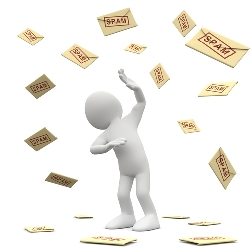Spam is unsolicited e-mail sent to many people. It is the electronic equivalent of the junk mail that is delivered to your home each week. Most spam is commercial advertising, get rich quick schemes or shady services with the sender paying very little of the actual e-mail delivery cost. Spam is usually sent from a fake e-mail address making it difficult to trace.
At ITS we provide filtering of incoming spam e-mail messages on Carleton University’s primary e-mail gateway.
How you can reduce Spam:
- Do not open an email that looks like Spam.
Just delete it. Simply opening the message can send a read receipt message back to the spammer confirming that your e-mail account is active.  Do not reply to a Spam message.
Do not reply to a Spam message.
Spammers will regard this as a ‘hit’ and your e-mail account will be confirmed as active.- Do not make your e-mail address available on web pages.
Use an alternate e-mail address when using Usenet newsgroups. Spammers use harvesting software that surfs the Internet to glean e-mail addresses from web sites and newsgroups. An alternate e-mail address will protect your Carleton e-mail address and help reduce the amount of spam received at Carleton. Free e-mail services are readily available from many sources. - Guard your e-mail address carefully.
Do not give your e-mail address to web sites unless you are sure what they are going to do with it. Read any terms of use and privacy statements. Many greeting card and joke-of-the-day websites gather e-mail addresses for spam use. Never subscribe your friends to a web site as you may be giving their address to a spammer.
How ITS Reduces the Amount of Spam you get:
SpamAssassin and RBL+
ITS blocks well known spam sites using the RBL+ list. ITS also uses SpamAssassin e-mail filtering software. SpamAssassin scans all incoming e-mail and tags suspected spam messages with a spam score. The spam score can be seen at the end of the subject line in the form of a row of asterisks (e.g. [******]).
Spam Score
The SpamAssassin filtering software scans all incoming e-mail and if it thinks that a message may be spam, it assigns the message a spam score.
The spam score goes from 5 to 9. 5 being a low spam score and 9 being a high spam score indicating that the message likely is spam. SpamAssassin immediately discards any messages scored at 10 or higher.
SpamAssassin does not flag messages scored at less than 5 because those messages are often legitimate.
Spam Folders
A spam folder is a mail folder that you create to hold any spam e-mail captured by your e-mail client’s local spam filtering rules. ITS recommends that your spam filters move e-mail to a folder rather than deleting it. A folder will allow you to review exactly what you are filtering in case any legitimate e-mail is tagged as spam.
You should review the e-mails in your spam folder to check for any legitimate messages. This can usually be done by scanning the sender and subject lines quite quickly. You should delete any spam regularly.
Legitimate Email vs Spam
SpamAssassin cannot be absolutely sure that a message is definitely spam. This could create situations where legitimate e-mail is discarded. ITS recommends that you create a spam filter using your local e-mail client (Outlook, Exchange, Netscape, Outlook Express…) that can identify spam that has been tagged by SpamAssassin and move it to a spam folder.
Legitimate messages tagged as Spam is almost certain to happen at some time. That is why ITS recommends that regularly review spam messages you have received before deleting them.